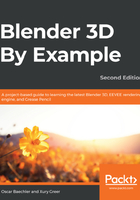
Using transformation hotkeys
Unlike the previous chapter, we're going to start this project from scratch, so open Blender, and if you don't already have a fresh scene, go to File | New | General. The default scene has a default cube, a point light, and a camera.
Before we get started on the time machine, let's introduce a few important hotkeys. As stated in the previous chapter, Blender is full of hotkeys. To take full advantage of the software, you'll want to memorize several of them.
Hotkeys are especially useful for things that you will be doing over and over again, in particular, switching between the three transformation tools (move, scale, and rotate), so let's go over how to use these hotkeys so we can work faster:
- G: Grab (Translate / Move)
- R: Rotate
- S: Scale
Blender takes a different approach to the majority of 3D software when it comes to these transformation hotkeys; unlike the buttons in the Toolbar, which activate manipulation widgets, these three transformation hotkeys immediately begin transforming the selected objects the moment you press the hotkey. No widget required!
Give it a try:
- Select the cube.
- Press the G hotkey to grab it.
- Move the mouse to translate the cube around the screen.
When you're done moving the cube, you need to either confirm the transformation by left-clicking or pressing the Enter key, or cancel the transformation by right-clicking or pressing the Esc key. This is true of all of Blender's hotkey operations, so take a moment to practice.
Next, try rotating the cube:
- Make sure the cube is still selected.
- Press the R hotkey to begin rotating it.
- Move the mouse to rotate the cube around its origin point.
- Confirm or cancel the rotation with the left or right mouse button, respectively.
It's pretty easy, right? Now, let's try scaling the cube:
- Make sure the cube is still selected.
- Press the S hotkey to begin scaling it.
- Move the mouse toward or away from the cube's origin point.
- Confirm or cancel the rotation with the left or right mouse button respectively.
Using these hotkeys is a lot faster than using the Toolbar once you commit them to memory. However, we need to combine these three hotkeys with a second set of hotkeys to get the same amount of precision as the tools in the Toolbar.
Remember, when we used the tools in the previous chapter, that we could transform our selected object along a specific axis: x, y, or z? Well, we can do that with hotkeys as well!
When you first press one of the three transformation hotkeys (G, R, or S), the transformation begins by using View Space (also known as Screen Space), and all movements are based on the current angle of the 3D Viewport. To lock the movement to one of the three axes (x, y, or z), all you have to do is press the corresponding letter. So, to move the cube straight up and down in Global Space (also known as World Space), press G to begin grabbing it, then press Z to lock to the z-axis. This is the same for any of the three axes:
- X: Lock transformation to the x-axis.
- Y: Lock transformation to the y-axis.
- Z: Lock transformation to the z-axis.
Locking to an axis works for grabbing, rotating, and scaling. You can also transform along two axes at once by holding Shift and pressing the letter for the axis that you don't want to include:
- Shift + X: Lock transformation to both the y and z axes.
- Shift + Y: Lock transformation to both the x and z axes.
- Shift + Z: Lock transformation to both the x and y axes.
For added precision, you can type the exact value of the transformation you wish to apply. For instance, to rotate an object 90 degrees along the x-axis, do the following:
- Press the R hotkey to begin rotating.
- Press the X hotkey to lock the rotation to the global x-axis.
- Type 90 on the keyboard to rotate exactly 90 degrees.
- Left-click or press the Enter key to confirm the rotation.
These hotkeys are meant to be intuitive since you will be using them a lot and, with a little practice, they will become second nature. From now on in this book, we will encourage you to use these hotkeys to transform objects. However, if you are more comfortable using the tools in the Toolbar, you may keep using them instead. The results will be identical, but you will work faster if you get used to using the hotkeys.
Next, we'll learn how to set up reference images in Blender so that we can see the concept art for the time machine directly in the Viewport.